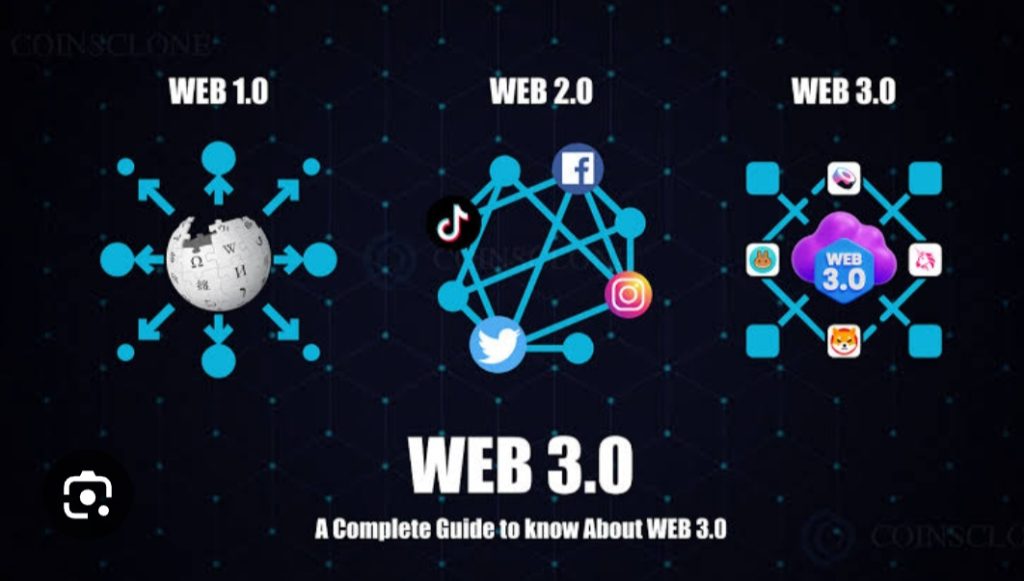Navigating the Web3 Revolution.
What is web3 technology?
Web3 technology refers to the set of technologies and concepts that underpin the development of the next generation of the internet, often referred to as “Web 3.0” or the “Decentralized Web.” Web3 technology aims to overcome some of the limitations and challenges of the current internet (Web 2.0) by incorporating decentralized, user-centric, and blockchain-based principles. It envisions a more open, transparent, and user-controlled digital environment. Here are the key components of Web3 technology:

- Decentralization: Unlike the centralized architecture of Web 2.0, Web3 emphasizes decentralization. Data and applications are distributed across a network of nodes, reducing the control of a single central entity.
- Blockchain Technology: Blockchain serves as the foundation of many Web3 applications. It is a distributed and immutable digital ledger that records transactions and data in a secure, transparent, and tamper-resistant manner.
- Smart Contracts: Smart contracts are self-executing programs that run on blockchains. They enable automated and trustless execution of agreements, allowing parties to interact directly without intermediaries.
- Decentralized Applications (DApps): DApps are applications built on blockchain and other decentralized technologies. These applications often operate on a peer-to-peer network and provide benefits like enhanced security, transparency, and user ownership.
- Cryptocurrencies and Tokens: Web3 technology integrates cryptocurrencies and tokens as native assets for transactions, value exchange, and ownership representation. Tokens can also be used to represent digital assets or access rights within DApps.
- Decentralized Identity: Web3 introduces decentralized identity systems, allowing users to have more control over their digital identities, data, and personal information. Users can manage their identities across different platforms without relying on centralized authorities.
- Interoperability: Web3 focuses on creating interoperability among different blockchain networks and protocols, enabling seamless communication and data exchange between platforms.
- Data Ownership and Privacy: Web3 emphasizes user ownership of data. Users have the ability to grant and revoke access to their data, enhancing privacy and control over personal information.
- Tokenization of Assets: Web3 enables the tokenization of real-world assets, allowing assets such as real estate, art, and intellectual property to be represented as digital tokens on the blockchain.
- NFTs (Non-Fungible Tokens): NFTs are unique digital tokens that represent ownership of specific items, such as digital art, collectibles, or in-game items. They have gained popularity as a way to establish digital ownership and provenance.
- Decentralized Finance (DeFi): DeFi refers to financial services and applications built on blockchain that aim to provide alternatives to traditional financial systems. These include lending, borrowing, trading, and yield farming.
- Decentralized Autonomous Organizations (DAOs): DAOs are organizations governed by smart contracts and operated by their members. They enable decentralized decision-making and voting mechanisms among participants.
How does work Web3?
Web3 works by leveraging blockchain technology, decentralized protocols, and various components to create a more user-centric, transparent, and decentralized internet experience. Here’s an overview of how Web3 works:
- Decentralization: At the core of Web3 is the idea of decentralization. Unlike traditional Web 2.0 services where data is stored on centralized servers owned by corporations, Web3 aims to distribute data and services across a network of nodes. This reduces the control of single entities and enhances security and censorship resistance.
- Blockchain Technology: Blockchain serves as the underlying technology for Web3. It’s a distributed, tamper-resistant digital ledger that records transactions in a transparent and secure manner. Blockchain ensures the integrity of data and provides a foundation for decentralized applications.
- Smart Contracts: Web3 applications often utilize smart contracts, which are self-executing contracts with the terms directly written into code. These contracts automate processes, enforce agreements, and enable trustless interactions between parties without the need for intermediaries.
- Cryptocurrencies and Tokens: Web3 employs cryptocurrencies (like Bitcoin or Ethereum) and tokens as mediums of value exchange. Cryptocurrencies are used for transactions, while tokens can represent ownership of assets or access rights within specific applications.
- Web3 Wallets: Web3 wallets (e.g., MetaMask) allow users to securely manage their cryptocurrency holdings, interact with DApps, and sign transactions. These wallets hold users’ private keys, enabling them to control their digital assets and data.
- Decentralized Applications (DApps): DApps are applications built on blockchain and distributed technologies. They operate without central control, often using smart contracts to perform tasks. Users interact with DApps through web browsers or specialized interfaces.
- Decentralized Identity (DID): Web3 introduces the concept of decentralized identity, where users have ownership and control over their digital identities. DIDs enable users to maintain their identity across platforms and grant access to their data on a need-to-know basis.
- Interoperability: Web3 emphasizes interoperability between different blockchain networks and protocols. This enables seamless communication and data exchange across various platforms, fostering innovation and reducing fragmentation.
- NFTs (Non-Fungible Tokens): NFTs are unique digital tokens representing ownership of specific items. They’re used in Web3 for digital art, collectibles, gaming assets, and more. NFTs provide verifiable ownership and provenance of digital assets.
- Decentralized Finance (DeFi): DeFi applications are a subset of Web3 that focuses on creating financial services using blockchain technology. DeFi platforms offer services such as lending, borrowing, trading, and yield farming, without traditional financial intermediaries.
- Decentralized Autonomous Organizations (DAOs): DAOs are organizations governed by smart contracts and controlled by their members. DAOs enable collective decision-making and voting, allowing participants to shape the direction of the organization.
In essence, Web3 shifts control from centralized entities to users and the community. It introduces mechanisms that promote transparency, security, and user ownership of data and assets. The integration of blockchain, smart contracts, cryptocurrencies, and decentralized protocols creates a new paradigm for how applications and services are developed and used on the internet.

